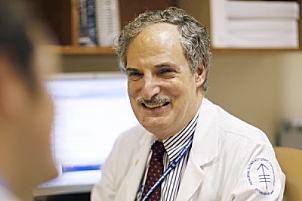A cover story on Healio.com’s current issue of the online publication HemOnc Today draws attention to the risks associated with radiation treatment for Hodgkin lymphoma — an issue that’s been a matter of concern in the hematology and oncology research communities for nearly two decades.
In 1998 an article published in The New England Journal of Medicine titled “Risk of Second Cancers after Treatment for Hodgkin’s Disease“ by American Cancer Society Professor of Clinical Oncology S.A. Rosenberg, M.D., and others, estimated the risk of second cancers among 1,507 patients with Hodgkin lymphoma treated at Stanford University Medical Center in the previous 20 years found that 83 second cancers were found more than one year after diagnosis.
This compares to 15.9 projected on the basis of rates in the general population, with a mean 15-year risk of all second cancers of 17.6 percent, of which 13.2 percent were due to solid tumors.
Risk of leukemia appeared to reach a plateau level of 3.3 percent at 10 years, whereas non-Hodgkin lymphoma continued to increase, to 1.6 percent by the end of the follow-up period.
HemOnc Today notes that since Stanford University radiologist Henry Kaplan, M.D., pioneered the use of radiation therapy (RT) for treating Hodgkin lymphoma in 1962, the technique has, along with chemotherapy, become a front-line treatment for patients with Hodgkin lymphoma (HL), and now, about 90 percent of early-stage patients are cured. Compare that to the 1960s, when the five-year overall survival rate was about 10 percent.
But there’s a downside. A substantial proportion of patients who receive these treatment regimens suffer serious and sometimes fatal long-term side effects, such as cardiovascular disease, radiation fibrosis syndrome, and second cancers. These risks are especially troubling due to the fact that Hodgkin lymphoma occurs most frequently in people who are 20 to 34 years old.
In a 2011 Open Access article published in the journal Therapeutic Advances in Hematology, titled “Long-Term Survivorship at a Price: Late-Term, Therapy-Associated Toxicities in the Adult Hodgkin Lymphoma Patient,” author David J. Straus, M.D., an attending physician on the Lymphoma Service in the Department of Medicine at Memorial Sloan Kettering Cancer Center in New York, says there have been increasing numbers of survivors of successful treatment of Hodgkin lymphoma over the past 30 years.
However, Straus says that while these survivors may be cured of HL, the long-term morbidity and mortality associated with late toxicities of treatment have become matters of increasing concern, and that identification of these late complications is needed to devise strategies to manage them when they happen, and hopefully decrease the risk of their development.
 Straus, who has a longstanding clinical research interest in malignant lymphomas, has authored more than 150 publications on this topic and conducted clinical trials in Hodgkin lymphoma, cutaneous T-cell lymphomas, and HIV-associated lymphomas, as well as studies assessing quality of life and survivorship issues among people with lymphoma. He says second malignancies followed by cardiovascular disease are the leading causes of late morbidity and mortality, but an array of other late complications of primary treatment of HL and autologous stem cell transplantation attributable to damage caused by radiation treatment for Hodgkin lymphoma are also being identified, such as musculoskeletal difficulties, endocrine abnormalities including sterility and thyroid disease, heart and lung damage, persistent fatigue, and psychosocial distress.
Straus, who has a longstanding clinical research interest in malignant lymphomas, has authored more than 150 publications on this topic and conducted clinical trials in Hodgkin lymphoma, cutaneous T-cell lymphomas, and HIV-associated lymphomas, as well as studies assessing quality of life and survivorship issues among people with lymphoma. He says second malignancies followed by cardiovascular disease are the leading causes of late morbidity and mortality, but an array of other late complications of primary treatment of HL and autologous stem cell transplantation attributable to damage caused by radiation treatment for Hodgkin lymphoma are also being identified, such as musculoskeletal difficulties, endocrine abnormalities including sterility and thyroid disease, heart and lung damage, persistent fatigue, and psychosocial distress.
Straus concludes that use of less-toxic therapies, especially limiting the use of radiation treatment, may contribute to reducing late morbidity and mortality of lymphoma survivors and further research into the overall health status and quality of life of lymphoma survivors is necessary. Also, guidelines for follow-up of HL survivors should be developed on the basis of real comprehensive data, along with strategies to pre-emptively address anticipated potential medical and psycho-social problems.
On his Sloan Kettering website, Straus says he is documenting and attempting to improve outcomes for long-term Hodgkin lymphoma survivors, and also directing multi-institutional clinical trials evaluating new treatments for elderly patients with aggressive non-Hodgkin lymphoma whose disease relapsed after initial chemotherapy, and in patients with advanced cutaneous T-cell lymphomas.
A 2015 study published in the journal of the American Society of Clinical Oncology titled “Radiation Dose-Response Relationship for Risk of Coronary Heart Disease in Survivors of Hodgkin Lymphoma,” co-authored by  Frederika A. van Nimwegen and Flora E. van Leeuwen, Ph.D., of the Netherlands Cancer Institute in Amsterdam, observes that cardiovascular diseases are increasingly recognized as late effects of Hodgkin lymphoma treatment and
Frederika A. van Nimwegen and Flora E. van Leeuwen, Ph.D., of the Netherlands Cancer Institute in Amsterdam, observes that cardiovascular diseases are increasingly recognized as late effects of Hodgkin lymphoma treatment and  that the purpose of their study was to identify risk factors for coronary heart disease (CHD), and to quantify the effects of radiation dose to the heart, chemotherapy, and other cardiovascular risk factors.
that the purpose of their study was to identify risk factors for coronary heart disease (CHD), and to quantify the effects of radiation dose to the heart, chemotherapy, and other cardiovascular risk factors.
The investigators conducted a nested case-control study in a cohort of 2,617 five-year HL survivors, treated between 1965 and 1995 who were diagnosed with CHD as their first cardiovascular event after HL. Detailed treatment information was collected from the medical records of 325 cases and 1,204 matched controls, with radiation charts and simulation radiographs used to estimate in-field heart volume and mean heart dose (MHD).
The researchers found that the median interval between HL and CHD was 19.0 years, and that risk of CHD increased linearly with increasing MHD, resulting in a 2.5-fold increased risk of CHD for patients receiving an MHD of 20 Gy from mediastinal radiotherapy, compared with patients not treated with mediastinal radiotherapy. They conclude that the linear radiation dose-response relationship identified can be used to predict CHD risk for future HL patients and survivors, and suggest that appropriate early management of CHD risk factors and stimulation of physical activity may reduce CHD risk in HL survivors.
 In an accompanying editorial, “Minimizing Cardiac Risks With Contemporary Radiation Therapy for Hodgkin Lymphoma,“ authors Maja V. Maraldo of the University of Copenhagen in Denmark and Andrea K. Ng of the Dana-Farber Cancer Institute and Brigham and Women’s Hospital in Boston, Massachusetts, note that the association
In an accompanying editorial, “Minimizing Cardiac Risks With Contemporary Radiation Therapy for Hodgkin Lymphoma,“ authors Maja V. Maraldo of the University of Copenhagen in Denmark and Andrea K. Ng of the Dana-Farber Cancer Institute and Brigham and Women’s Hospital in Boston, Massachusetts, note that the association  between chest radiation therapy for Hodgkin lymphoma and cardiac complications was first reported almost 50 years ago. They said Hancock and others from Stanford University established that the risk is related to doses to the mediastinum, with several studies since then focusing mostly on childhood and breast cancer survivors, who have associated cardiac RT dose with increased risk of cardiac morbidity and mortality.
between chest radiation therapy for Hodgkin lymphoma and cardiac complications was first reported almost 50 years ago. They said Hancock and others from Stanford University established that the risk is related to doses to the mediastinum, with several studies since then focusing mostly on childhood and breast cancer survivors, who have associated cardiac RT dose with increased risk of cardiac morbidity and mortality.
Maraldo and Ng observe that the role of radiation therapy in Hodgkin lymphoma is an intensely debated topic, with recent data suggesting that elimination of radiation in early-stage HL may adversely affect disease control and survival, and that for patients with HL requiring mediastinal radiation therapy, findings from the study by van Nimwegen lend support to the effort to limit cardiac doses to as low as reasonably achievable, with the three principal strategies for reducing critical organ exposure being radiation dose reduction, radiation field/volume reduction, and use of modern RT planning and delivery techniques.
The editorial authors relate that for patients with early-stage HL and low-risk disease according to the German Hodgkin Study Group (GHSG) criteria, the GHSG HD10 trial showed that radiation dose can be safely de-escalated from 30 Gy to 20 Gy after two cycles of doxorubicin, bleomycin, vinblastine, and dacarbazine (ABVD).
Although the GHSG HD11 trial did not support reducing RT dose to 20 Gy in patients with risk factors after ABVD chemotherapy, there is data showing that in some cases of early-stage, unfavorable HL with complete metabolic response to adequate chemotherapy, doses of 20 to 24 Gy yield excellent long-term in-field control, suggesting that dose de-escalation can be considered in these patients, especially when doses to the heart and lung are unacceptably high because of disease distribution.
As a second strategy for minimizing radiation exposure, Maroldo and Ng cite RT field/volume reduction, noting that availability of more effective systemic therapy, modern staging and restaging imaging studies, and CT-based RT planning has enabled the transformation of radiation therapy for lymphoma from extended-field RT (EFRT), mantle-field RT, and involved-field RT (IFRT) to involved-node/involved-site RT (INRT/ISRT). They said that until the late 1980s to early 1990s, EFRT was commonly used in HL therapy, which required field matching that has been shown to result in higher (up to 50 percent more than prescribed) total dose to the heart at the junction of the mantle and subdiaphragmatic fields, and is associated with a significantly increased risk of subsequent coronary heart disease. They note that reduction from EFRT to mantle field is an improvement, but say a standard mantle field is still associated with substantial radiation exposure to the heart.
A third strategy cited by Maroldo and Ng is employment of modern RT technology, noting that the historical EFRT, mantle-field RT, and IFRT were all based on two-dimensional radiation planning, which relied on bony landmarks on plain films, thereby inevitably resulting in unnecessary exposure of large volumes of normal tissue due to uncertainty in targeting.
However, they observe that current standards of ISRT/INRT are CT based, with far more accurate targeting and sparing of normal tissue, and that additional new technology, including intensity-modulated RT (IMRT) and proton beam therapy, has allowed further improvement in conformality compared with traditional three-dimensional conformal RT (3D-CRT), and that although not yet widely available, proton beam therapy is a modality that may gain increasing acceptance as more efficacy data becomes available.
Finally, they say that simple maneuvers, such as the deep-inspiration breath-hold technique, have been shown in multiple studies to further decrease doses to heart and lungs in patients receiving mediastinal RT, resulting in reduced estimated years of life lost from late effects of the treatment.
Maroldo and Ng contend that the time has come time to move away from reports that simply present dosimetric comparisons, and on to studies that provide estimated cardiac risks. They said it is important for future studies to confirm that these treatment modifications, as well as early-detection and prevention strategies, will translate to a reduction in cardiac-specific mortality in HL survivors.
 In an accompanying commentary on the Helio cover story, Bouthaina Dabaja, an associate professor in the Department of Radiation Oncology at the University of Texas MD Anderson Cancer Center in Houston, Texas, notes that radiation therapy is a local therapy. Consequently, it is important to identify who might benefit from RT among patients with advanced Hodgkin lymphoma (stage 3 or 4) and a large disease distribution. She maintains that large radiation fields are nothing but a source of unacceptable long-term toxicities, and that paying attention to radiation delivery to avoid toxicity is a priority achievable by abandoning involved-field RT and by using involved-site RT according to modern guidelines to better target the area of interest with small margins so that surrounding organs receive very limited doses.
In an accompanying commentary on the Helio cover story, Bouthaina Dabaja, an associate professor in the Department of Radiation Oncology at the University of Texas MD Anderson Cancer Center in Houston, Texas, notes that radiation therapy is a local therapy. Consequently, it is important to identify who might benefit from RT among patients with advanced Hodgkin lymphoma (stage 3 or 4) and a large disease distribution. She maintains that large radiation fields are nothing but a source of unacceptable long-term toxicities, and that paying attention to radiation delivery to avoid toxicity is a priority achievable by abandoning involved-field RT and by using involved-site RT according to modern guidelines to better target the area of interest with small margins so that surrounding organs receive very limited doses.
Flora van Leeuwen, Ph.D., co-author of one of the studies cited above, and group leader of the Psychosocial Research and Epidemiology Group at the Netherlands Cancer Institute, says the group focuses on two principal research lines: assessment of the long-term risks of second malignancy and cardiovascular disease following treatment of Hodgkin’s lymphoma, breast cancer, testicular cancer, and childhood malignancy; and assessment of the roles of hormone-related and genetic risk factors in the etiology of breast, ovarian, and endometrial cancer.
Van Leeuwen observes that with curative treatment now available for a substantial group of cancer patients, it is increasingly important to evaluate how the occurrence of late complications of treatment affects their long term survival, and to make an overall assessment of the influence of various treatments on the total burden of adverse events, as determined by the number of events and their severity, such as the group’s special focus on identifying genotypes associated with a stronger increase of radiation-induced cancer and anthracycline-associated heart disease.


